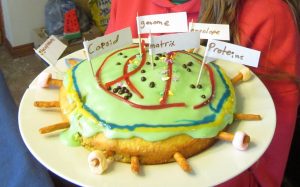VIRUSES lesson 7: Inside a Capsid
Lots of drawing and coloring in this lesson!
We look inside the capsids of 6 viruses, we see how virologists make linear diagrams of genome information, and we learn how virologists classify viruses. I decided that it was too much for one page, so you will need to print out two template pages. I have put both template pages into one PDF, so be aware that the download contains two pages.
Part(a) runs 68 minutes, but a lot of it is coloring time. There is an optional intermission at the 51 minute mark (after we complete the top half of the page), but you can take a break sooner than that if you need to.
This download contains both template pages you will need:
Template pages for Virus lesson 7
You might also want to print this info page. It gives a written description of what we learn in this lesson.
If you need to see the final drawing, here is the one I did on camera:
Final drawing sample Virus lesson 7a
Part (b) Viral Classification
This part is 18 minutes long.
************************************
ACTIVITY IDEAS:
Activity 7.1: Memory match game
How many viruses can you identify? This game uses 12 diagrams of viruses, giving a simple schematic cross section that shows the arrangement of the genome inside the capsid. You can see a preview of the virus shapes in the game by downloading this pdf page: Virus diagrams info page
https://matchthememory.com/virusshapes
Activity 7.2: Capsid Cookies
Use your favorite “sugar cookie” recipe to make edible viruses! You can make your cookies gluten-free, egg-free, low sugar, organic, or whatever suits you. You can also choose colorings that are all-natural, or you can skip the colorings and candy all together and provide your cookie makers with all natural treats such as nuts and fruits. The point is that it’s a fun way to review virus anatomy.
TIP: I often make edible paint by adding some food coloring to an egg yolk (or beaten egg). The paint is applied before baking. This a great way to add some color without adding any extra sugar.
ALSO: If you want to use pretzel spikes, stick them in before baking. If you want to use marshmallows, stick them on after baking.
AND… here is another edible idea, submitted by a student taking this course. She did a cake instead of cookies.
***********************************
SUPPLEMENTAL VIDEOS:
This video is an introduction for non-scientists that the genomes of viruses (and bacteria) can be sequenced using samples of from a number of different patients in different locations and this will let the scientists be able to figure out who infected whom. Each time a virus replicates inside an organism, little mistakes are made by the copy machines. (Remember, most viruses don’t have spell checkers!) In order to make treatments and vaccines that work, we need to know what those changes have been and what they are likely to be in the future.
Here is a 5-minute interview with a virologist from Scotland who went to West Africa during the recent Ebola epidemic (2013-2016) to set up a field lab and attempt to sequence the genome of Ebolavirus. His team is working with the university in Sierra Leone to try to establish a permanent infectious disease lab that can research not only Ebola but other viruses, as well.
Here is another video about the work being done in Sierra Leone to track the mutations in the Ebolavirus genome over time. The researched will explain why studying the virus genome is so important. (It’s a short video, less than 5 minutes.)
Ready to take the quiz?
If you can’t access the online quiz, here is a PDF version you can print.



